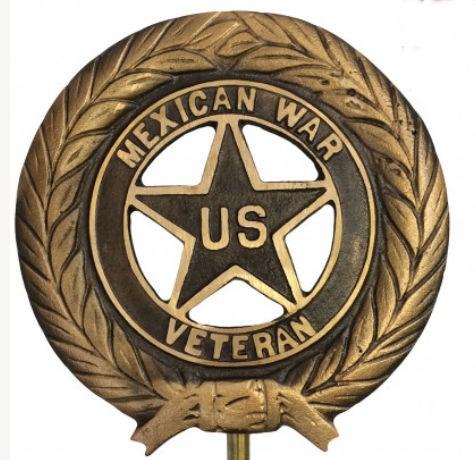
John Green 1823 — 1876 Charles Ladd 1827 — 1913 Levi Moore 1807 1900 James O’Riley (Riley) 1820 1913
Sauk County in the Mexican War
The Mexican–American War, also known in the United States as the Mexican War and in Mexico as the Intervención estadounidense en México (United States intervention in Mexico), was an armed conflict between the United States and Mexico from 1846 to 1848. It followed the 1845 American annexation of Texas, which Mexico still considered its territory. Mexico refused to recognize the Velasco treaty, because it was signed by President Antonio López de Santa Anna while he was captured by the Texan Army during the 1836 Texas Revolution. The Republic of Texas was de facto an independent country, but most of its Anglo-American citizens wanted to be annexed by the United States.
Sectional politics over slavery in the United States were preventing annexation because Texas would have been admitted as a slave state, upsetting the balance of power between Northern free states and Southern slave states. In the 1844 United States presidential election, Democrat James K. Polk was elected on a platform of expanding U.S. territory to Oregon, California (also a Mexican territory) and Texas; by any means, with the 1845 annexation of Texas furthering that goal. But the boundary between Texas and Mexico was disputed, with the Republic of Texas and the U.S. asserting it to be the Rio Grande and Mexico claiming it to be the more-northern Nueces River. Polk sent a diplomatic mission to Mexico in an attempt to buy the disputed territory, together with California and everything in between for US $25 million; an offer the Mexican government refused. The U.S. sent troops to the disputed Rio Grande, ignoring Mexican demands to withdraw. Mexico subsequently attacked a group of 80 soldiers on April 25, 1846, a move which Polk used to convince the Congress of the United States to declare war.
Beyond the disputed area of Texas, U.S. forces quickly occupied the regional capital of Santa Fe de Nuevo México along the upper Rio Grande. U.S. forces also moved against the province of Alta California and then turned south. The Pacific Squadron of the U.S. Navy blockaded the Pacific coast in the lower Baja California Territory. The U.S. Army, under Major General Winfield Scott, invaded the Mexican heartland and captured the capital, Mexico City, in September 1847.
Although Mexico was defeated on the battlefield, negotiating peace was a politically fraught issue. Some Mexican factions refused to consider any recognition of its loss of territory. Although Polk formally relieved his peace envoy, Nicholas Trist, of his post as negotiator, Trist ignored the order and successfully concluded the 1848 Treaty of Guadalupe Hidalgo. It ended the war, and Mexico recognized the cession of present-day California, Nevada and Utah as well as parts of present-day Arizona, Colorado, New Mexico and Wyoming. The U.S. agreed to pay $15 million for the physical damage of the war and assumed $3.25 million of debt already owed by the Mexican government to U.S. citizens. Mexico relinquished its claims on Texas and accepted the Rio Grande as its northern border with the United States.
In Mexico, the war worsened domestic political turmoil. Since the war was fought on home ground, Mexico suffered a large loss of life of both soldiers and civilian population. The nation's financial foundations were undermined, and more than half of its territory was lost. Mexico felt a loss of national prestige, leaving it in what a group of Mexican writers, including Ramón Alcaraz and José María del Castillo Velasco, called a "state of degradation and ruin...” This group did not acknowledge Mexico’s refusal to admit the independence of Texas as a cause of the war, instead proclaiming “[As for] the true origin of the war, it is sufficient to say that the insatiable ambition of the United States, favored by our weakness, caused it.”1
2
1846 1848


3
1846 1848
Sauk County in the Mexican War
Racine Advocate May 26, 1846


Racine Advocate January 27, 1847

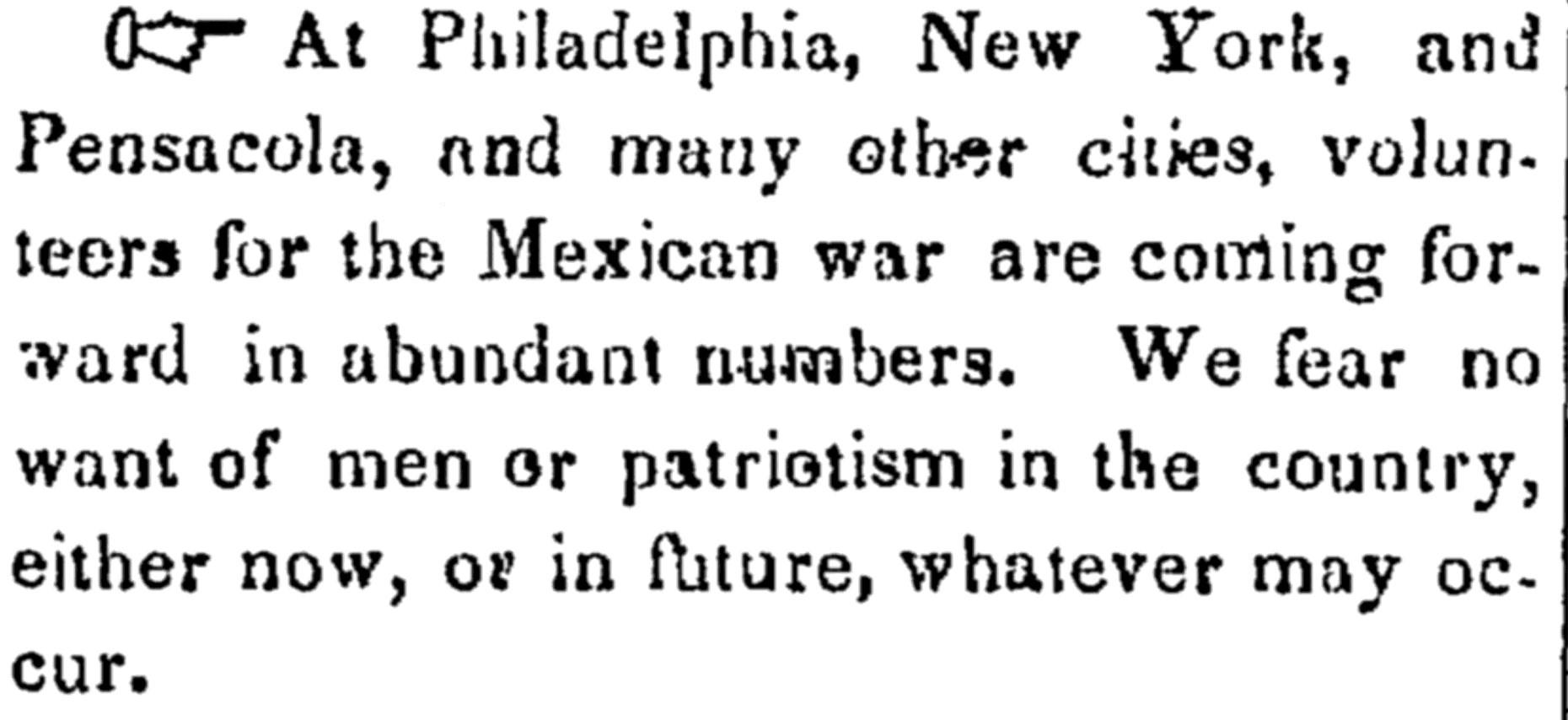
4
1846 1848
Sauk County in the Mexican War
Sauk County in the Mexican War


5
1846
1848

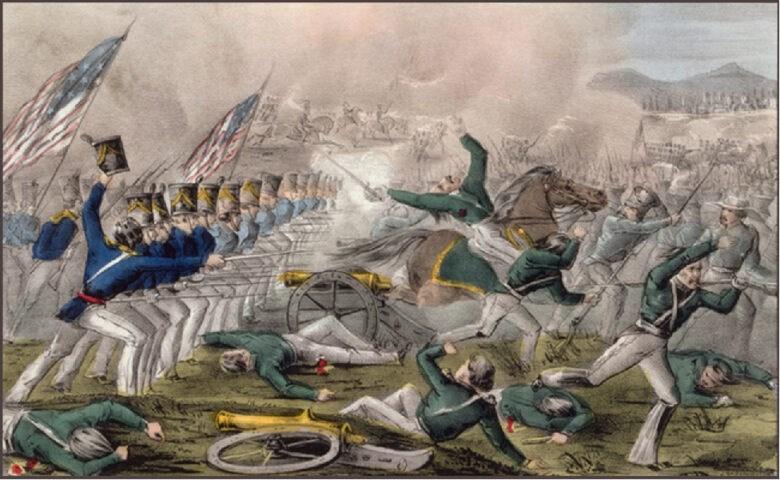

6 Sauk County in the Mexican War 1846 1848
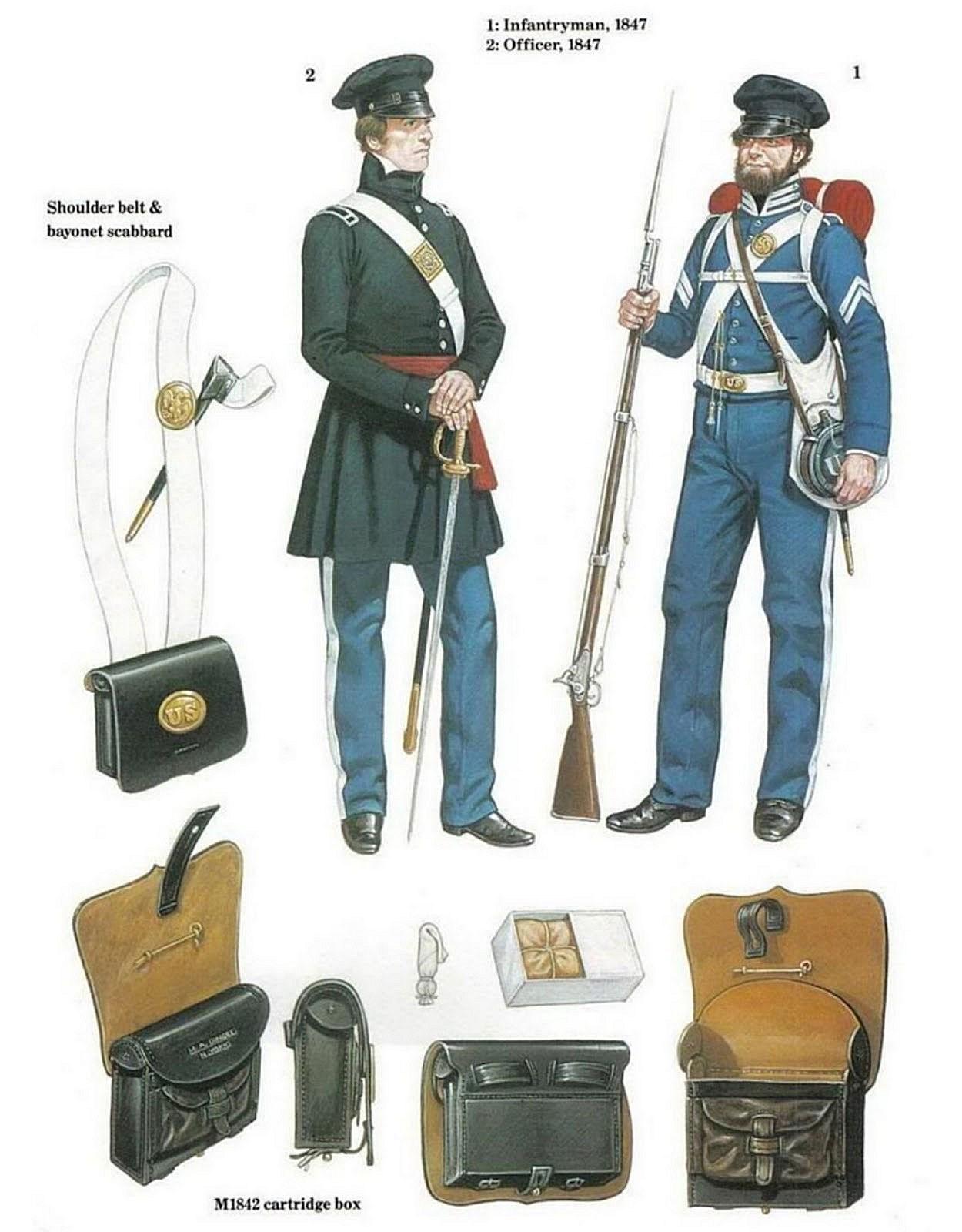
7 Sauk County in the Mexican War 1846 1848
-
-
-
-
https://www.quora.com/What
color
were-American-uniforms
during-the-Mexican
War
Grant County Herold
Feb. 19, 1848

The militia are the natural strength of the country: their strength and efficacy depends upon their organization and discipline. Wisconsin has an extended frontier, and in the event of an Indian war would be more exposed than any other part of the United States; hence the absolute necessity for a prompt organization of her militia. The government is now engaged in war with Mexico, and Wisconsin may be called on to furnish volunteers, and should be prepared, at all times, to meet the calls of the general government. The volunteers engaged in the Mexican war have proven to foreign powers that our citizen soldiers are equal to any troops that have ever faced an enemy. I have always entertained the opinion that the standing of our government in the estimation of foreign powers greatly depends upon our knowledge of arms, and our willingness to use them on all proper occasions.

8
1846 1848
Sauk County in the Mexican War
John Green
21April 1823 30 Aug. 1876

Mexican War (1846 1848)
Birth Date Calculator
Based on the death date listed on his tombstone, this calculation indicates that John Green was born on 21 April, 1823.

9
John Green
21April 1823 30 Aug. 1876

Mexican War (1846 1848)
1870 US Census

10
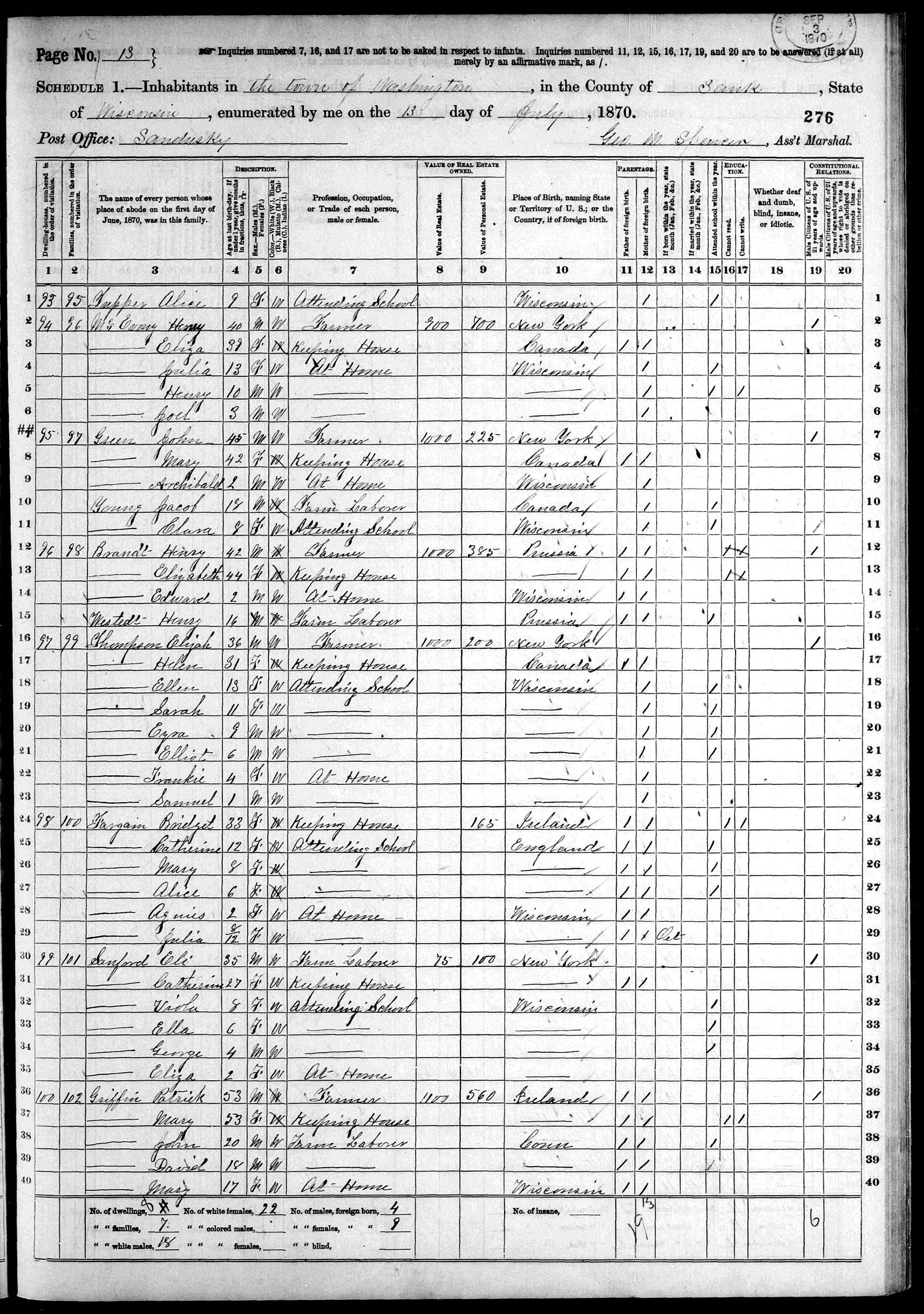
11
21April 1823 — 30 Aug. 1876 Mexican War (1846 1848) 1870 US Census
John Green
John Green

21April 1823 30 Aug. 1876


Mexican War (1846 1848)
Westfield Cemetery, Sauk County, WI

12
21April 1823
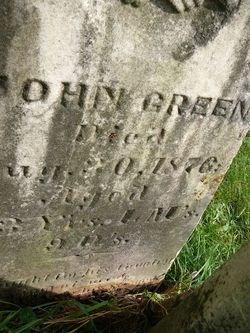

30 Aug. 1876

13
Photo, above, taken in 2019, right, taken in 2008
John Green
Mexican War (1846 1848)
Westfield Cemetery, Sauk County, WI
“He fought for his country in its time of need, he has gone to his reward.”
Charles S. Ladd

Feb. 20, 1827 Feb. 17, 1913
Mexican War (1846 1848)

14
Charles S. Ladd
Feb. 20, 1827 Feb. 17, 1913

Mexican War (1846 1848)
The Battle of Chapultepec was a battle between American forces and Mexican forces holding the strategically located Chapultepec Castle just outside Mexico City, fought 13 September 1847 during the Mexican–American War. The building, sitting atop a 200-foot hill, was an important position for the defense of the city.

The battle was part of the campaign to take Mexico City, for which General Winfield Scott's U.S. Army totaled 7,200 men. General Antonio López de Santa Anna, commander of the Mexican army, had formed an army of approximately 25,000 men. Mexican forces, including military cadets of the Military Academy, defended the position at Chapultepec against 2,000 U.S. forces. The Mexicans' loss opened the way for the Americans to take the center of Mexico City.
Although it lasted only about 60–90 minutes, the battle has great importance in the histories of both countries.4
It was at this battle that Charles S. Ladd lost his arm. He survived.
15
The Battle of Chapultepec Castle Library of Congress, Washington, D.C.
Charles S. Ladd
Feb. 20, 1827 Feb. 17, 1913
Mexican War (1846 1848)
On March 9, 1847, U.S. forces under General Winfield Scott invaded Mexico three miles south of Vera Cruz. They encountered little resistance from the Mexicans massed in the fortified city of Vera Cruz, and by nightfall the last of Scott’s 10,000 men came ashore without the loss of a single life. It was the largest amphibious landing in U.S. history and not surpassed until World War II. By March 29, with very few casualties, Scott’s forces had taken Vera Cruz and its massive fortress, San Juan de Ulua. On September 14, Scott’s forces reached the Mexican capital.
In February 1848, representatives from the United States and Mexico signed the Treaty of Guadalupe Hidalgo, formally ending the Mexican War, recognizing Texas as part of the United States, and extending the boundaries of the United States west to the Pacific Ocean.2
His greatest glory came during the Mexican-American War, when as the highest ranking general in the US Army, Scott created the tactics that would enable the United States military to defeat the Mexican forces and successfully conquer Texas, New Mexico, Nevada, California, Utah, Arizona, Colorado, Oklahoma, and part of Wyoming permanently. A successful amphibious invasion of the city of Vera Cruz, which Scott used as the staging area for an overland trek to Mexico City, during which numerous successful battles were fought, enabled US forces to rapidly conquer Mexico. With long supply lines, Scott’s forces often took food and material they needed from Mexican civilians; Scott himself forced the citizens of Mexico City to pay a large ransom to support his occupation forces while a final peace treaty was negotiated.3
16
Charles S. Ladd
Feb. 20, 1827 Feb. 17, 1913
Mexican War (1846 1848)
The Evening News Aug. 11, 1905

Excerpt
Charles S. Ladd at Merrimac is a veteran of that [Mexican War] struggle. He enlisted at Springfield, Mass., in the regular army which was being recruited for the Mexican war. In July 1847, he became a member of company B. Third Reg., Third artillery and sailed from Governor island, New York, for Vera Cruz. He marched with Gen. Scott from Vera Cruz to the City of Mexico and in all the centuries of war there has never been such a march. Hundreds died by disease which was more terrible than battle. Almost the final fight was to Chapultepec and there Mr. Ladd lost his right arm. He then returned to Fortress Monroe where he received his discharge. Excerpt: The Evening News – August 11, 1905

17
Charles S. Ladd

Feb. 20, 1827 Feb. 17, 1913


Mexican War (1846 1848)

18
Charles S. Ladd
Feb. 20, 1827 Feb. 17, 1913



Mexican War (1846 1848)

19
Charles S. Ladd
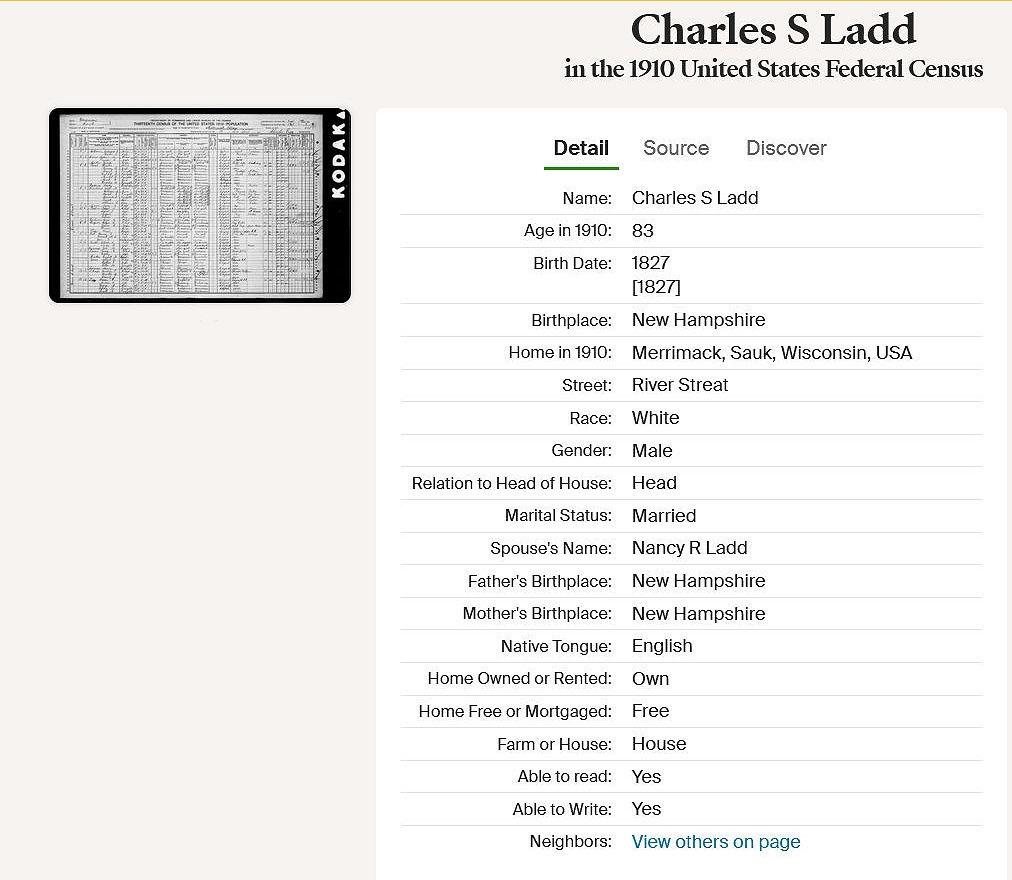
Feb. 20, 1827 Feb. 17, 1913
Mexican War (1846 1848)

20
Charles S. Ladd
Feb. 20, 1827 Feb. 17, 1913

Mexican War (1846 1848)
1910 Federal Census
Charles S. Ladd #83 above

21
Charles S. Ladd
Feb. 20, 1827 Feb. 17, 1913
Mexican War (1846 1848)
Baraboo News October 6, 1910
Baraboo News, May 10, 1905
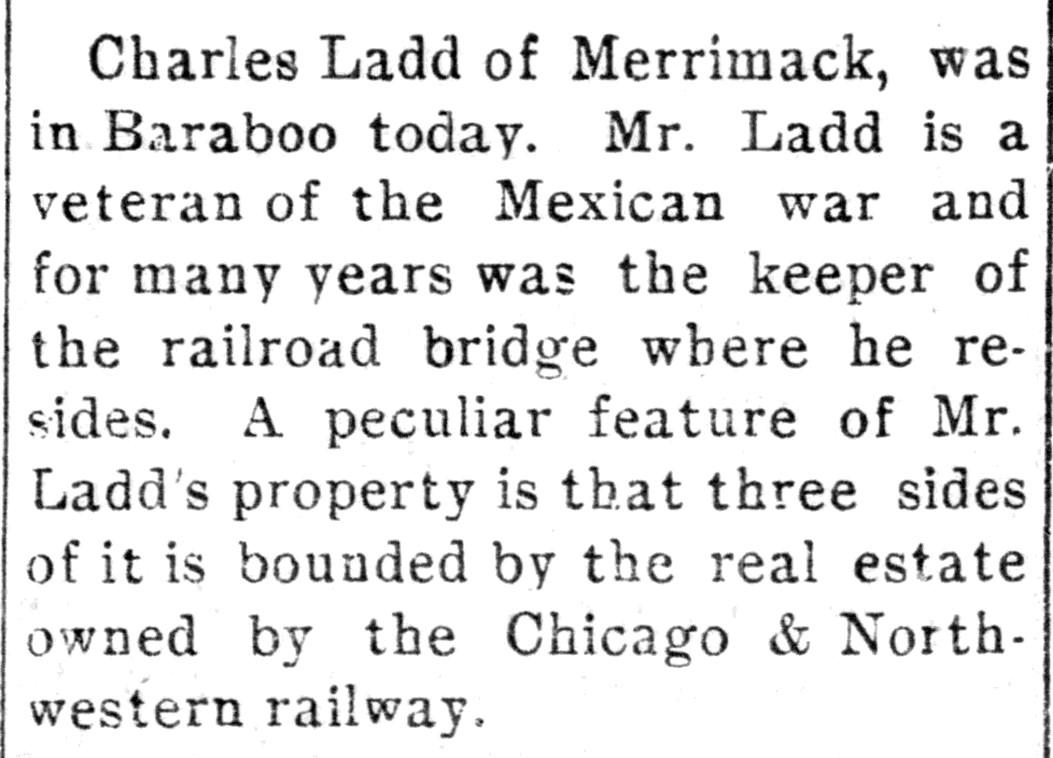


CHARLES S, LADD, OF MERRIMACK Mr. Ladd, who shared Mexican war honors, was a New Hampshire man and left an arm on a battlefield of the far South. In 1873 he settled in Merrimack and for years was a watchman on the Chicago & North Western bridge at that locality. He died a month after the decease of Mr. O'Riley, eighty-six years of age. H.E. Cole, Standard History of Sauk County, P. 334-336.

22
Charles S. Ladd
Feb. 20, 1827 Feb. 17, 1913
Mexican War (1846 1848)
Baraboo Daily News February 17, 1913


*

*Isaac Joiner, as mentioned in the second to last paragraph above, did not serve in the Mexican War. According to his records, he was a soldier in the Civil War only.

23
Charles S. Ladd
Feb. 20, 1827 Feb. 17, 1913
Mexican War (1846 1848)
Baraboo Republic, Feb. 20, 1913


Portage Daily Register, Feb. 18, 1913

24
Charles S. Ladd
Feb. 20, 1827 Feb. 17, 1913
Mexican War (1846 1848)
The Evening News,Aug. 11, 1905

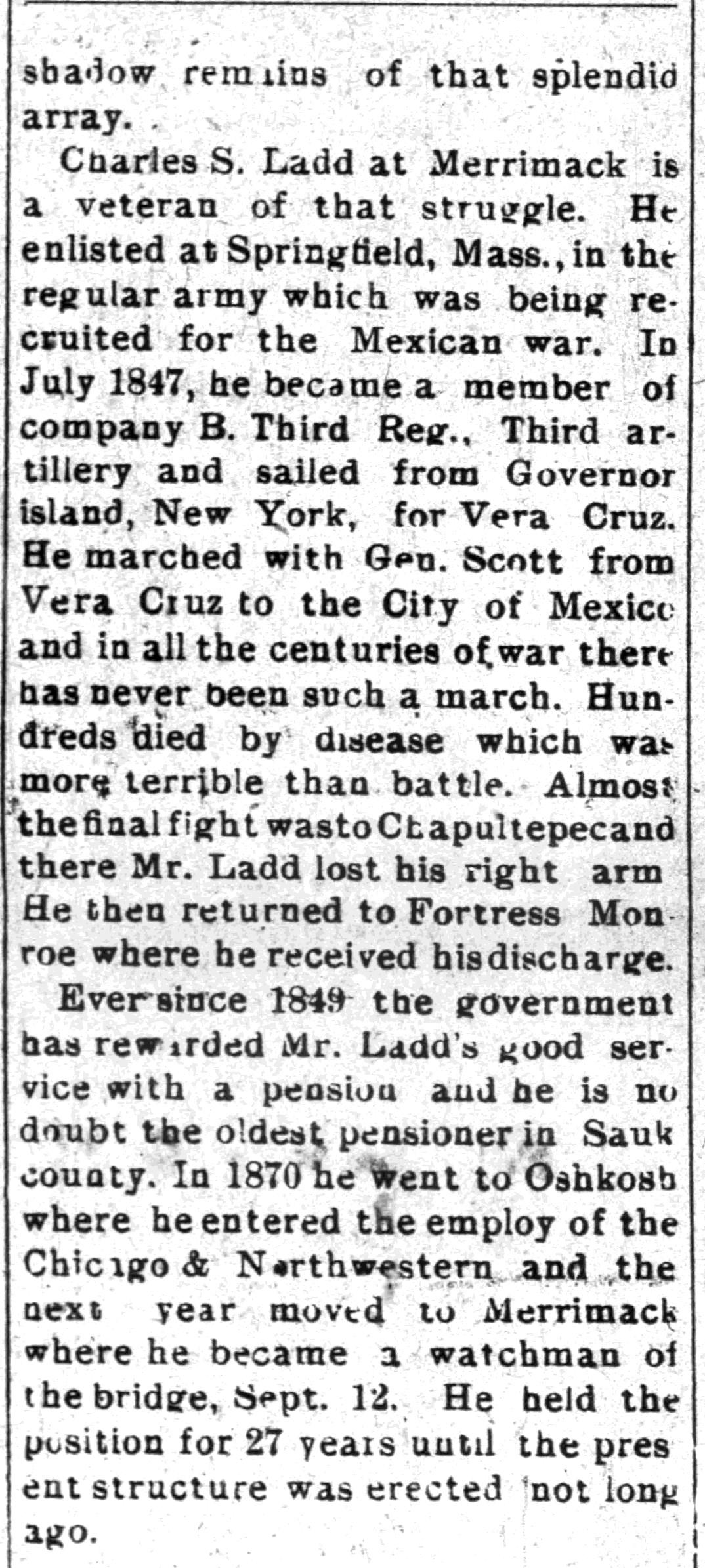

25
Charles S. Ladd
Feb. 20, 1827 Feb. 17, 1913

Mexican War (1846 1848)

26
Charles S. Ladd
Feb. 20, 1827 Feb. 17, 1913

Mexican War (1846 1848)

27
Charles S. Ladd - Oak Hill Cemetery, Merrimac, WI
Captain Levi Moore
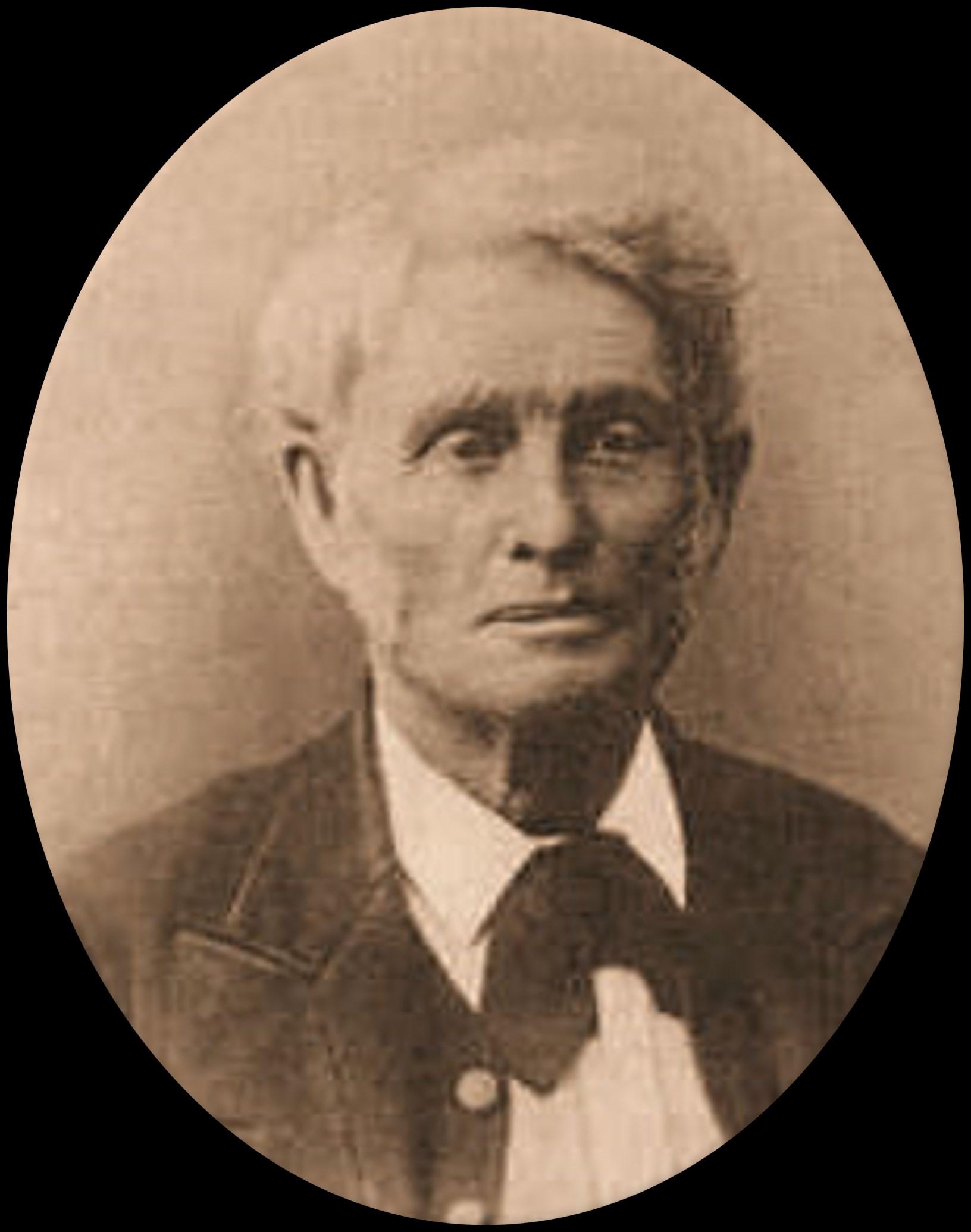
17 Dec. 1807 19 Nov. 1900
Mexican War (1846 1848)
28
Captain Levi Moore
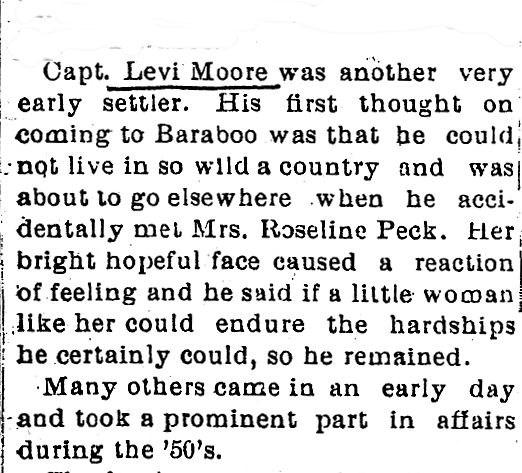

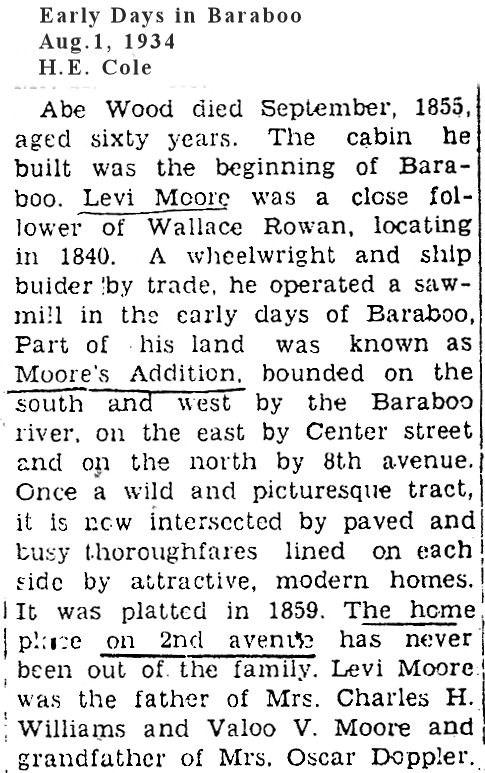

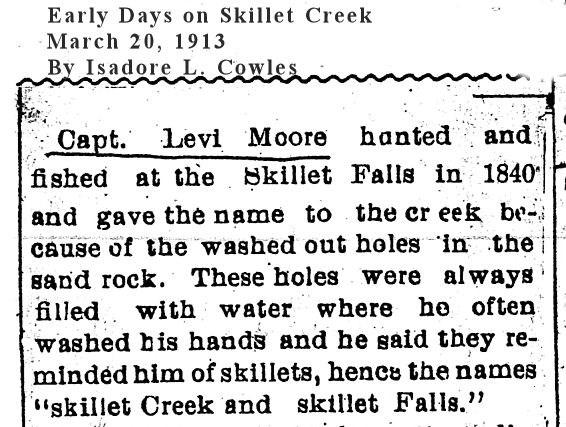

29
17 Dec. 1807 19 Nov. 1900 Mexican War (1846 1848)
Captain Levi Moore


30
17 Dec. 1807 19 Nov. 1900 Mexican War (1846 1848)
Captain Levi Moore
17 Dec. 1807 19 Nov. 1900

Mexican War (1846 1848)
SHERIFF’S SALE
By virtue of three Executions issued out of the county Court of Sauk county, State of Wisconsin, in favor of Erastus Marvin Plaintiff, and against the goods chattles (sic) and real estate of Levi Moore defendant, for the want of sufficient goods and chattles whereon to levy, I have levied upon the following described real estate to wit; the undivided half of se ¼ of sec 34, in township 12, north of range 6 east, together with one half of the water power, on said quarter section, excepting the village of Lyons, and one acre of land near the north east corner of said piece of land owned and occupied by John B. Crawford, which I shall schnt (?) public venders to the highest bidder at the Court House in the Village of Baraboo in said county, on the 30th day of April 1853, between the hours of one and two o’clock P.M., to satisfy said executions and costs.
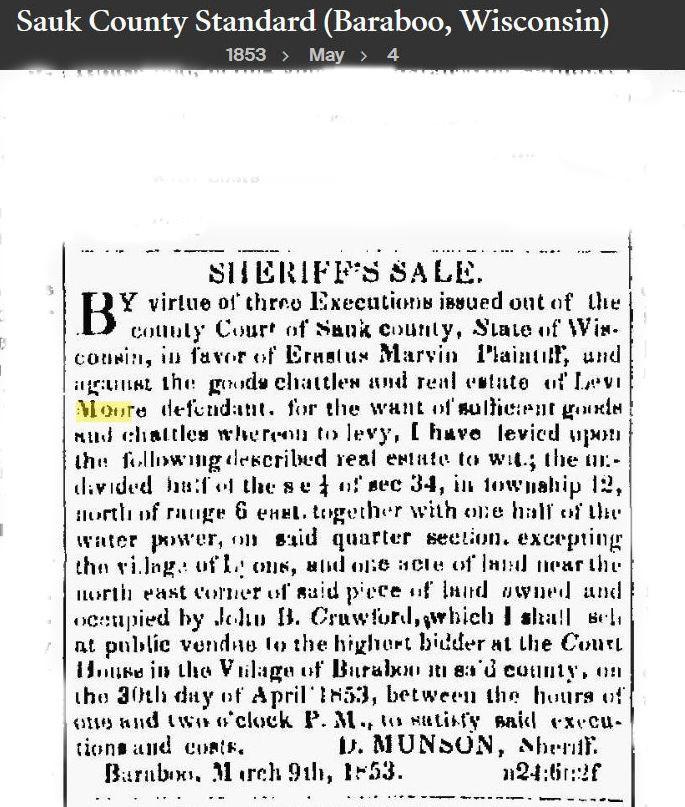 D. MUNSON, Sheriff
D. MUNSON, Sheriff
Baraboo, March 9th, 1853
31
Captain Levi Moore
17 Dec. 1807 19 Nov. 1900

Mexican War (1846 1848)
CAPT. LEVI MOORE In the early years of his youth and manhood Capt. Levi Moore, one of the founders of the milling interests of Baraboo and otherwise a leading, early resident of that city, "followed the lakes" as a sailor and the owner and navigator of a vessel. He first shot the rapids at Grand Rapids, Wisconsin, and in the early '40s became acquainted with Skillet Creek and Baraboo. Clinging closely to the explanation of his title, it should be added that in 1846 the men of Sauk County had so strong a notion of organizing a military company that they recommended the lake captain as a proper person to command and drill them. Governor Dodge, in fact, commissioned him captain, although the company which he was to lead was never organized. But Captain he was, and Captain he remained through life a double-barreled Captain. H.E. Cole, Standard History of Sauk County, P. 334-336.

32
Captain Levi Moore
17 Dec. 1807 19 Nov. 1900
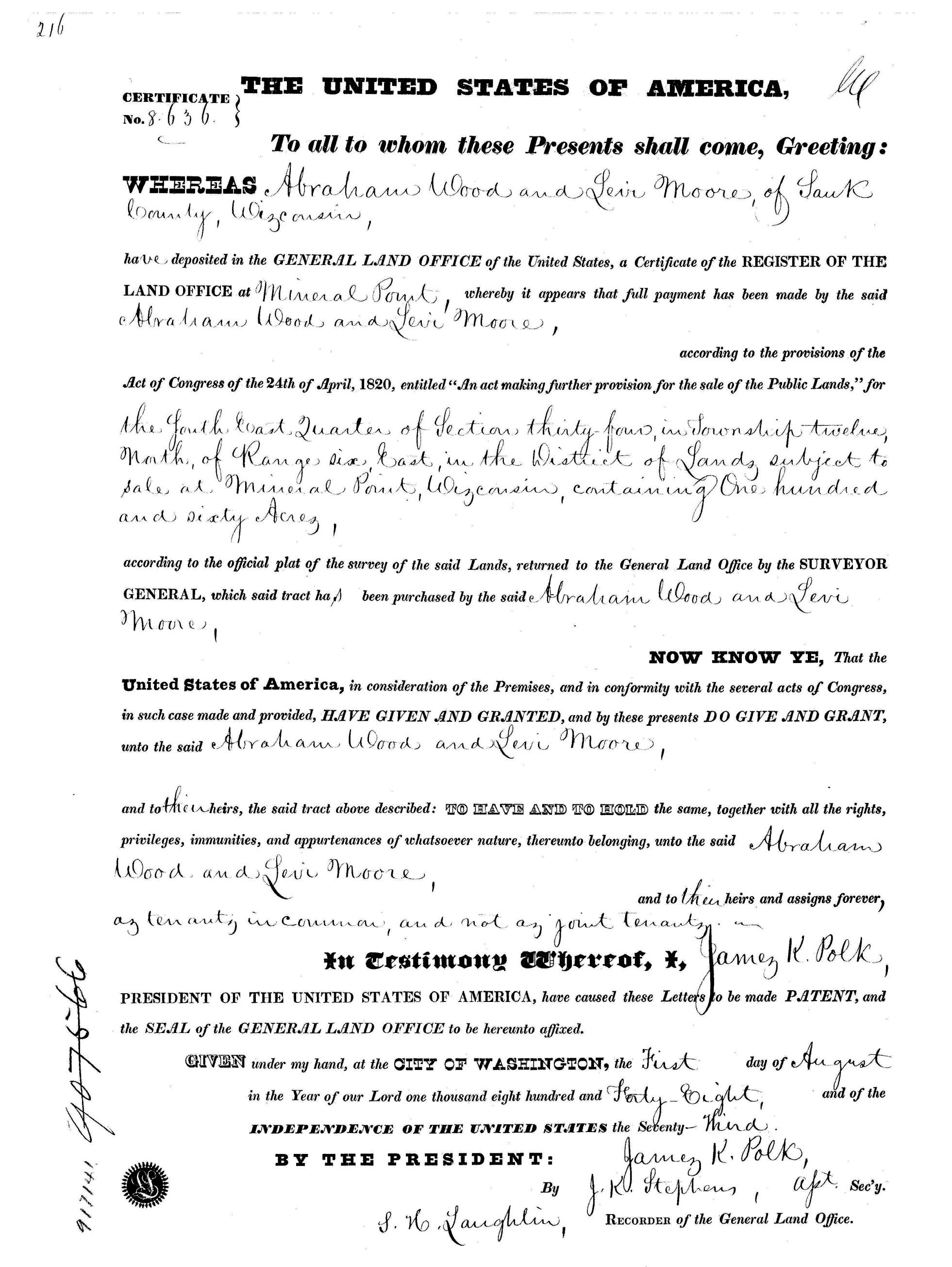
Mexican War (1846 1848)

33
Captain Levi Moore
17 Dec. 1807 19 Nov. 1900
Baraboo Republic Dec, 22, 1897



Baraboo Republic Aug. 8, 1894

34
Captain Levi Moore

17 Dec. 1807 19 Nov. 1900

Mexican War (1846 1848)
Continued on next page
35
Capt. Levi Moore Walnut Hill Cemetery, Baraboo
Continued on the next page
Captain Levi Moore
17 Dec. 1807 19 Nov. 1900
Outline Sketches of Sauk County
It's History, from the First Marks of Man's Hand to 1841, Author: Canfield, William H. Repository: Media: Book Page: Page 133 "Death of Captain Moore", "Old and Highly Respected Citizen Passed Away on Sunday" Text: After a long illness with cancer Capt. Levi Moore, died Sunday afternoon, Nov 18, at five o'clock at his home on Second Ave. Levi Moore was born in NY state, Essex county, Dec 17, 1807, and was the son of Joseph Moore, formerly of MA, but later of NY state and afterwards of OH, who did valiant service in the war of the revolution and whose brave deeds are now to be found in the records of MA. Levi, early in life, honed the pioneer spirit, and in the early days of OH went onto the lake as a sailor and served in all the capacities from cabin boy to captain and owner. That business at that time was carried on between Buffalo and the head of Lake Superior. In 1840 he came to WI, Sauk county, where he located. Six years after his arrival in the county he married Miss Deborah Stevens. Their children now living are two daughters and a son. Mr. Moore was connected in various ways with the pioneer history of the county. He developed the first water power on the Baraboo River where the Island Woolen Mills now stand and his mill turned out the lumber with which much of the early building was done. He also manufactured brick for building purposes at a later period. His last industry was cranberry cultivation, which he followed for many years. Mr. Moore was given to doing benevolent deeds of which the world knows but little, the needy and suffering never applied to him in vain. He bore his serious affliction of disease with patience and fortitude and was never heard to murmur. His wife and son were his devoted caretakers. The funeral was held from the house Tuesday afternoon. Rev. H. L. Udell, of the Free Congregational church officiating. The pall bearers were Wm. Andrus, Levi Cahoon, R. M. Andrus, Anson Case, Theron Case, O. B. Titus, all nephews of the deceased. Among those from abroad who attended the funeral were Mr. and Mrs. Levi Cahoon, R. A. Moore, Madison: Mrs. C. H. Williams and daughter, Florence of Fennimore.5
SAUK COUNTY DEMOCRAT
November 22, 1900
Text: "Almost 93, Captain Levi Moore Passes Away At A Ripe Old Age", Capt. Levi Moore died Sunday evening, Nov 18, at 5:00, on Second Ave., from cancer. Had he lived until the 17th of next month, he would have been 93 years of age. His death removes one of the historic figures of Baraboo, a man who has fought a great and good fight in life's battles, and who is esteemed by the entire population of the city. His death was expected as his advanced age and the character of this disease had placed a limit upon his days. Deceased was born in NY state, Essex Co., Dec 17, in the year 1807. He was the son of Joseph Moore, formerly from MA; later of NY state, and after a term of years came to the state of OH and made a permanent home. Joseph Moore did valiant service in the war of the Revolution, some of his brave deeds are now found in the archive records of MA. His son, Levi, young in life, showed the pioneer spirit and in the early days of OH went unto the lakes as a sailor and served in all the capacities as cabin boy, to captain, and owner. The business at that time was carried on between Buffalo and the head of Lake Superior. In 1840, he came to WI, Sauk Co., where he located. Six years after his arrival in the county, he married Deborah Stevens. Their children now living are two daughters and a son. Mr. Moore was connected in various ways with the pioneer history of the country. He developed the first water power on the Baraboo River where the Island Woolen Mills now stand, and his mill turned out the lumber with which much of the early building was done. He also manufactured brick for building purposes at a later period. His last industry was cranberry cultivation which he followed for many years. Mr. Moore was given to doing benevolent deeds of which the world knows but little. The needy and the suffering never applied to him in vain. He bore his serious affliction of disease with patience and fortitude.6
36
Captain Levi Moore
17 Dec. 1807 19 Nov. 1900

Mexican War (1846 1848)

37
Captain Levi Moore
17 Dec. 1807 19 Nov. 1900
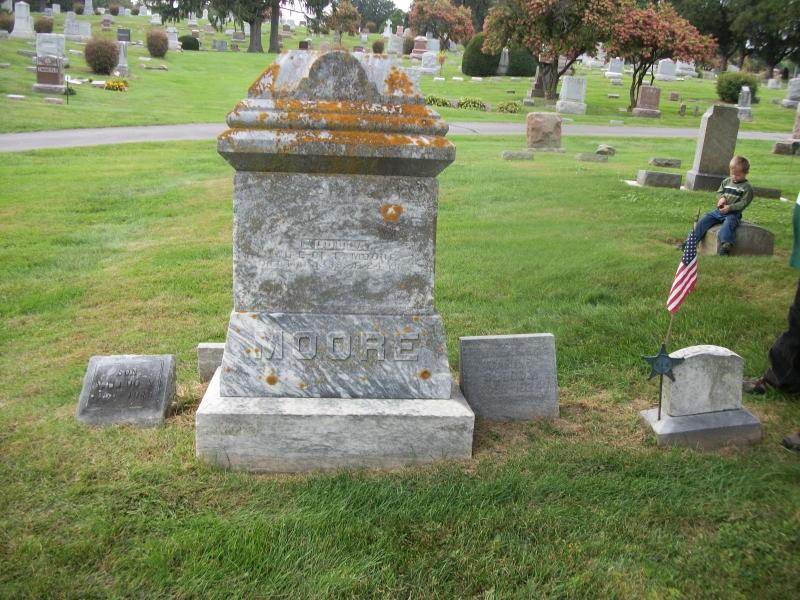

Mexican War (1846 1848)
Continued on next page
38
Capt. Levi Moore Walnut Hill Cemetery, Baraboo
Captain Levi Moore
17 Dec. 1807 19 Nov. 1900


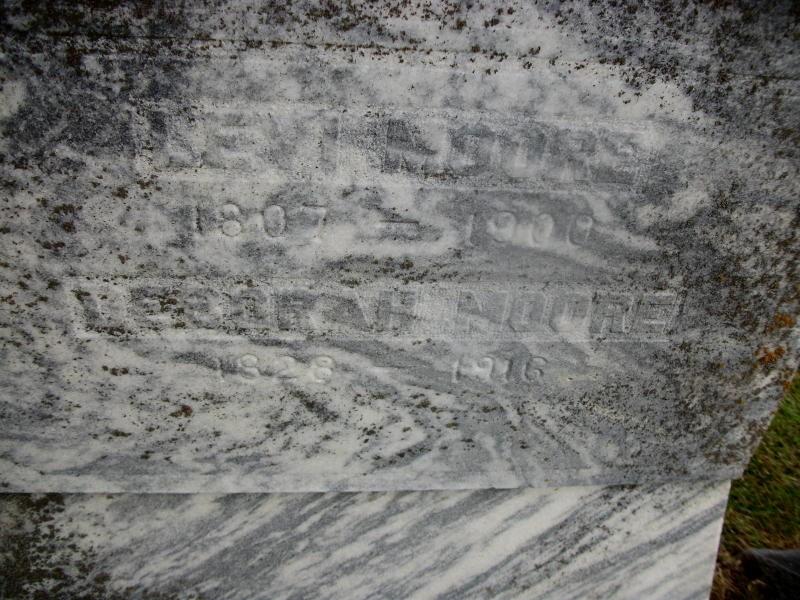
Mexican War (1846 1848)

39
Capt. Levi Moore Walnut Hill Cemetery, Baraboo
Captain Levi Moore
17 Dec. 1807 19 Nov. 1900

Mexican War (1846 1848)

40

41
James O'Riley 1820 - Jan. 1913
Mexican War (1846 1848)
James O'Riley
1820 - Jan. 1913

Mexican War (1846 1848)
Baraboo News March 17, 1910

42
James O'Riley
1820 - Jan. 1913
Mexican War (1846 1848)
Mr. O'Riley was a native Irishman who came to America in 1843 when twenty-three years of age. He landed in New York City on the 3d of July, at an hour when the town had already commenced to celebrate, and was greatly excited and somewhat alarmed over the unusual hub-bub and display of fireworks, giving him an absolutely new experience. He remained at the metropolis until the Mexican war broke out, enlisted in a New York company and boarded a sailing vessel bound for Monterey. Severe storms lengthened his voyage around Cape Horn, to his destination in Lower California, to a six months' trip. With his company, he fought at Monterey and did patrol duty at San Jose, California. At the conclusion of the war, instead of going home, he lingered in the gold regions with some thousands of other young men, for a year and a half, and then started for New York overland. He brought back some gold which he had minted into money at Philadelphia, and then decided to try his fortune in the West nearer the East than the Pacific Coast. Mr. O'Riley first took up a claim in the Town of Dellona, in May, 1850, was married in the following year and in the course of time became the father of twelve children. Impulsive by race and by nature, he joined the Union ranks in 1862, under the persuasion of a recruiting officer who met him on his way to Baraboo with a load of hogs. Mr. O'Riley joined Company F, Third Wisconsin Cavalry, when he reached the city, and served with that organization until the conclusion of the war. He continued to reside on his farm in Dellona until about 1900, when he purchased a home at Reedsburg and died there in January, 1913. He was in his ninety-fourth year, but up to the last a good, cheerful old man. H.E. Cole, Standard History of Sauk County, P. 334-336.
JAMES O'RILEY, OF REEDSBURG
43


44 1850 Census James Riley (O’Riley)
1820 - Jan. 1913
James O'Riley


45 1850 Census James Riley (O’Riley) James O'Riley 1820 - Jan. 1913

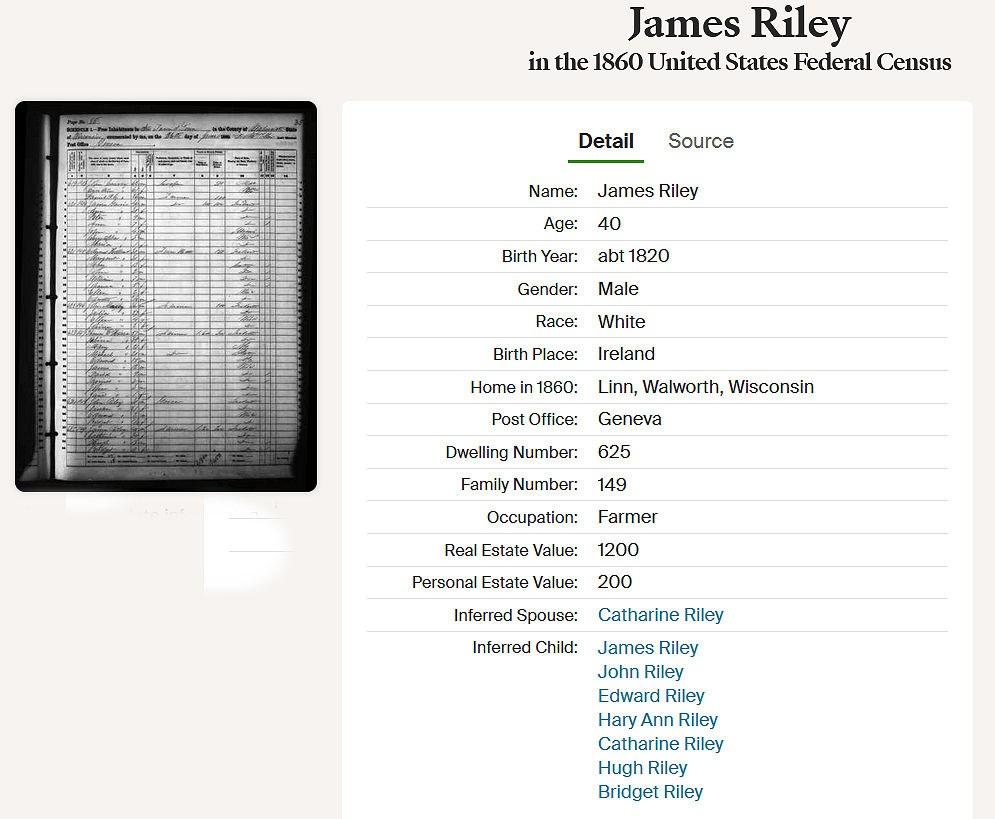
46 1860 Census James Riley (O’Riley)
1820 - Jan. 1913
James O'Riley


47 1860 Census James Riley (O’Riley)
1820 - Jan. 1913
James O'Riley
James O’Riley also served in theAmerican Civil War
Civil War Draft Registration Record

This registration record indicates that James Riley is eligible for the draft into the UnionArmy. He was registered here in June, 1863.

48
James O'Riley 1820 - Jan. 1913
Civil War Draft Registration Record


49
James O'Riley 1820 - Jan. 1913
James O’Riley also served in theAmerican Civil War
James O'Riley
1820 - Jan. 1913

Wisconsin in the Civil War Roster of Wisconsin Volunteers

50

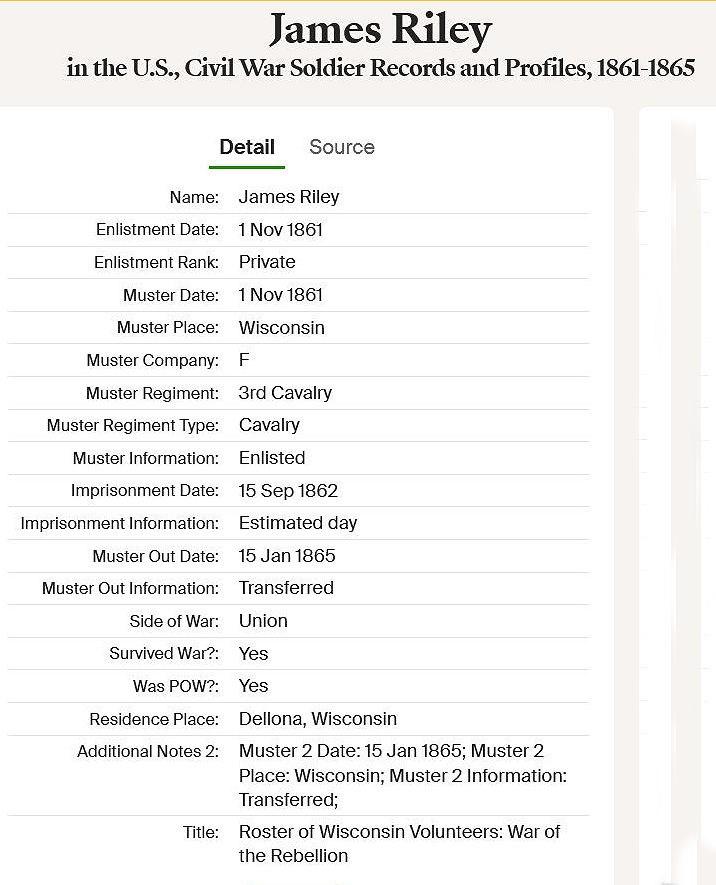
51
- Jan. 1913
James O'Riley 1820


52 1880 Census James Riley (O’Riley)
1820 - Jan. 1913
James O'Riley

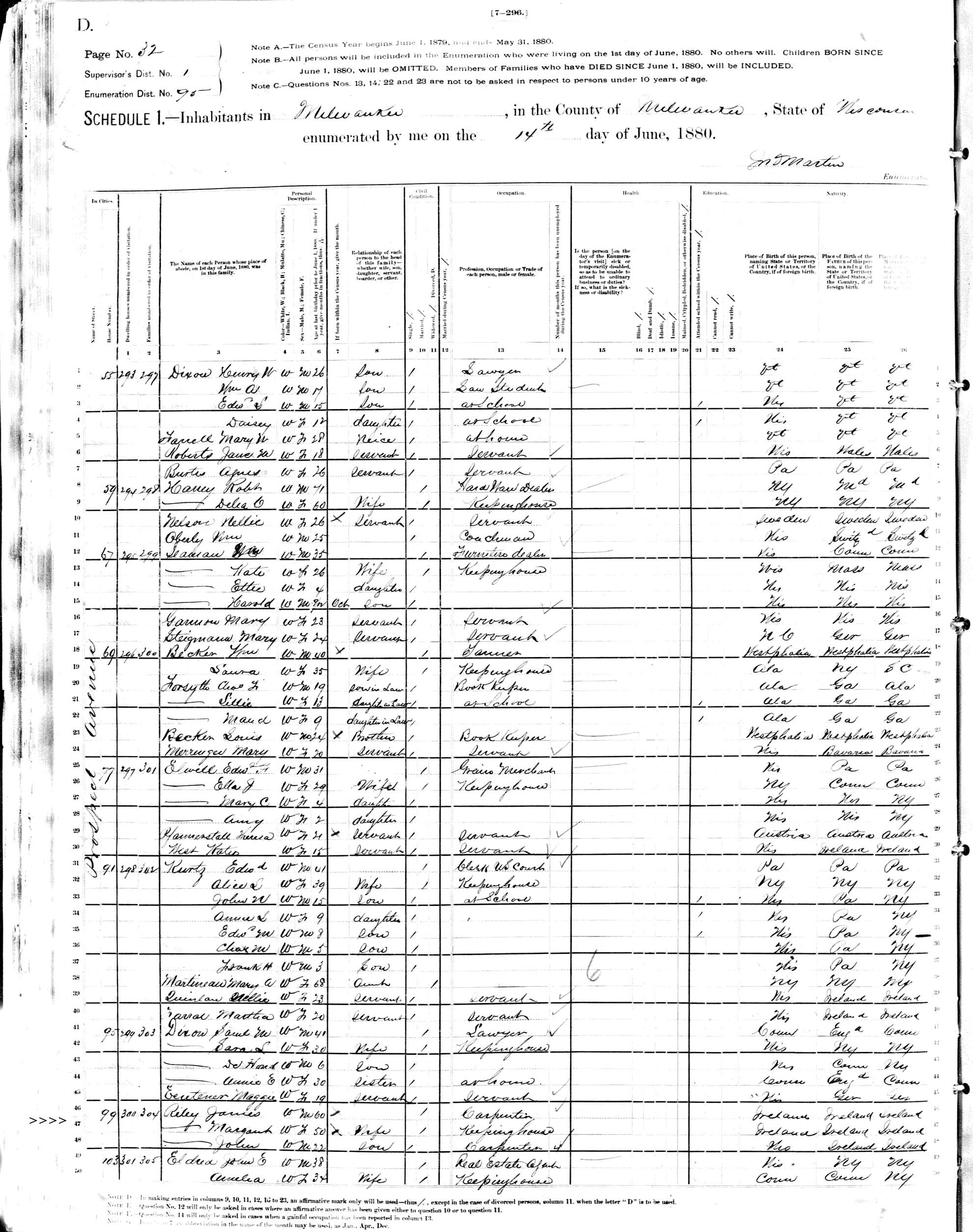
53 1880 Census James Riley (O’Riley) James O'Riley 1820 - Jan. 1913


54
1820 - Jan. 1913
James O'Riley


55
- Jan. 1913
James O'Riley 1820

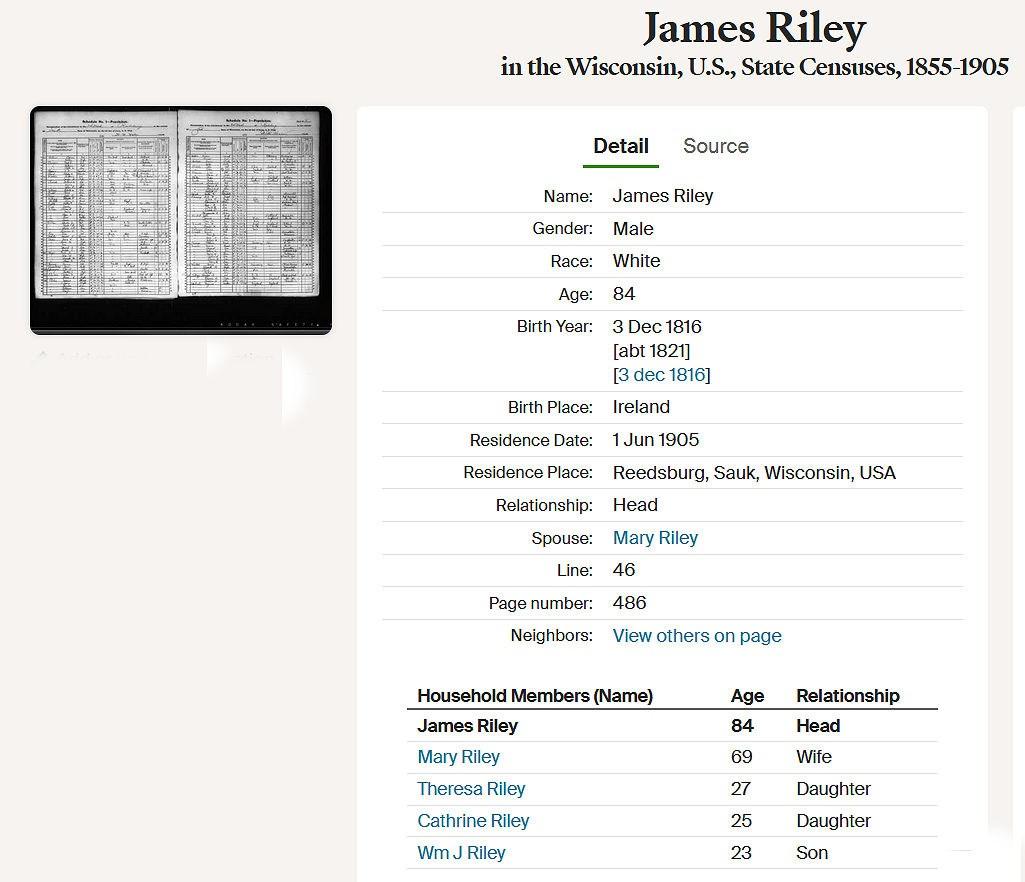
56 1905 Census James O’Riley
1820 - Jan. 1913
James O'Riley

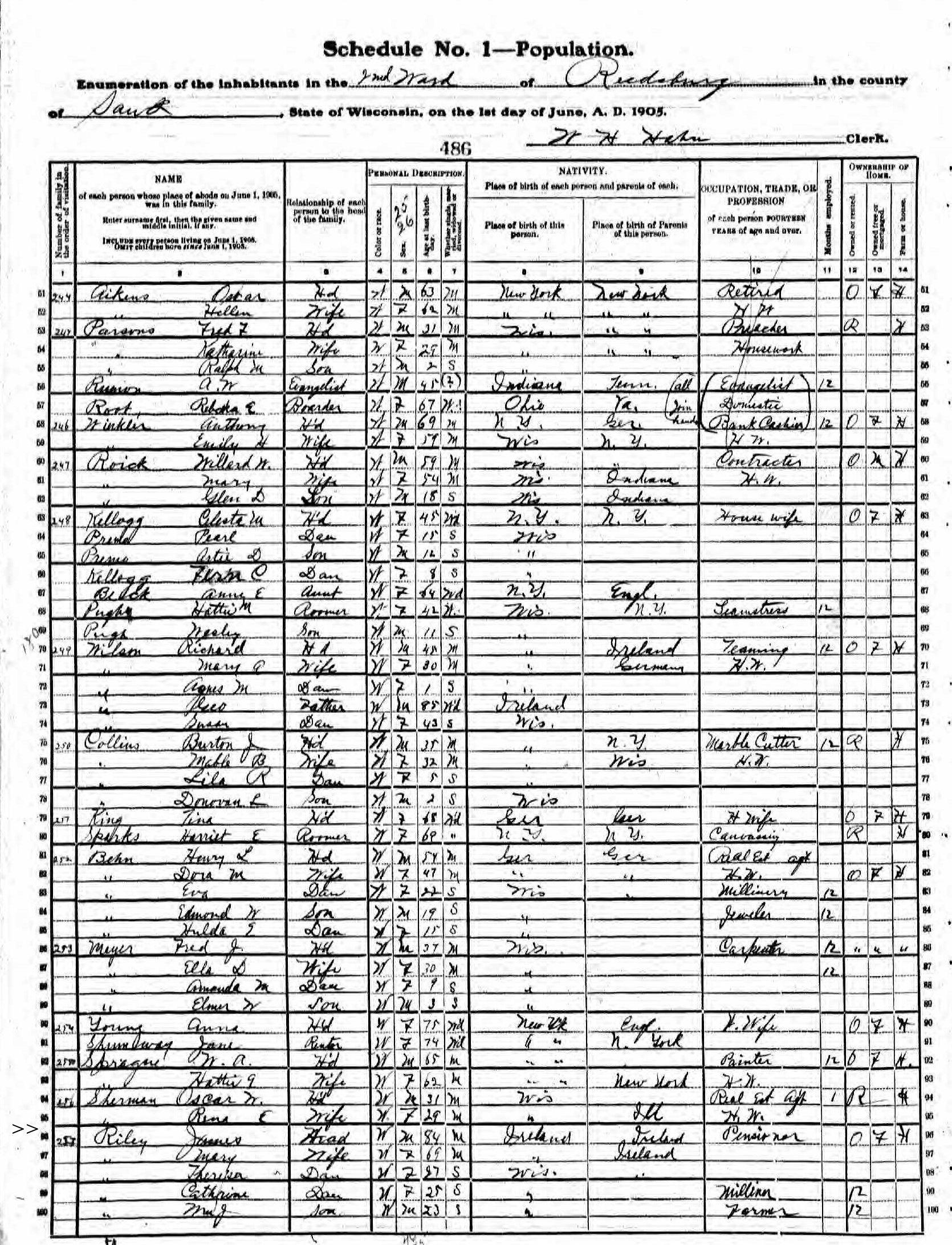
57 1905 Census James O’Riley James O'Riley 1820 - Jan. 1913


58 1910 Census James O’Riley James O'Riley 1820 - Jan. 1913


59 1910 Census James O’Riley
O'Riley 1820 - Jan. 1913
James






60 Baraboo Weekly News Feb. 6, 1913 James O'Riley 1820 - Jan. 1913 Mexican War (1846 1848)




61
O'Riley 1820 - Jan. 1913
James
Sources
1 https://en.wikipedia.org/wiki/Mexican%E2%80%93American_War
2 https://www.history.com/this-day-in-history/scott-captures-mexico-city
3 https://www.nps.gov/places/winfield-scott.htm
4 https://en.wikipedia.org/wiki/Battle_of_Chapultepec
5 State Historical Society of Wisconsin, Outline Sketches of Sauk County: It's History, from the First Marks of Man's Hand to 1841, Author: Canfield, William H. Repository
6 https://www.wisconsinhistory.org/Records/Newspaper/BA4880
7 https://jeffbridgman.com/inventory/index.php?page=out&id=4246
29-star American national parade flag, printed on coarse, glazed cotton. The stars are arranged in a double wreath pattern with a large center star and a flanking star in each corner of the brilliant blue canton. Note how the arms of the stars have an exaggerated length and thus bear a very interesting folk quality. This is one of my favorite early parade examples because of the great visual impact of its design.7
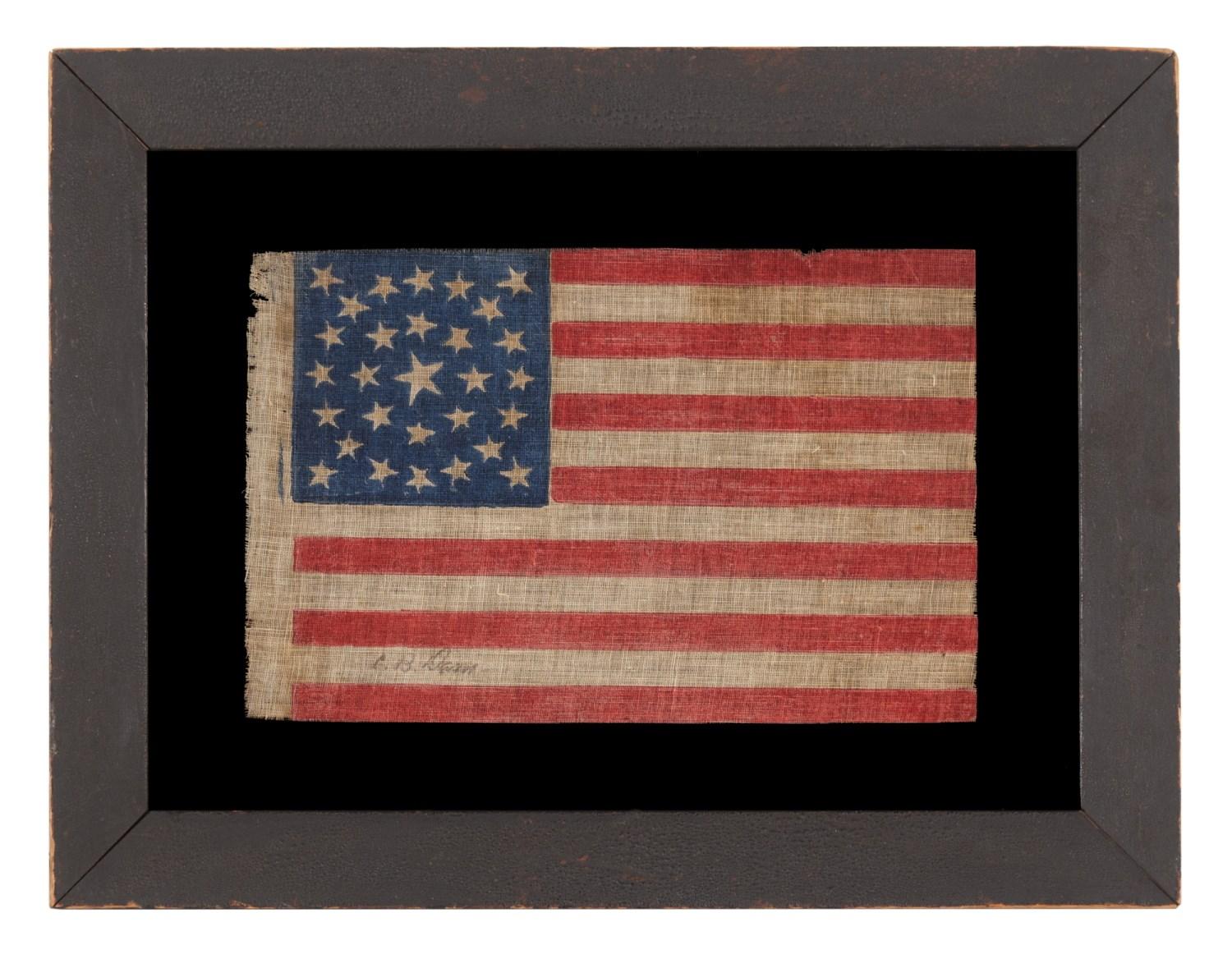
62
U.S. Parade flag used during the Mexican-American War
By William C. Schuette

63 This publication was researched and prepared for the Sauk County Historical Society
2023










































































 D. MUNSON, Sheriff
D. MUNSON, Sheriff


































































